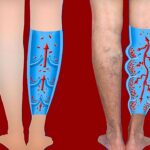The two distinct vascular disorders, arterial and venous insufficiency, both affect blood flow within the circulatory system. Even though both conditions result in compromised blood circulation, their root causes, symptoms, approaches to diagnosis and treatment differ. Understanding the distinction between the two is crucial for accurate diagnosis and tailored interventions.
Arterial Insufficiency
This condition is characterized by insufficient blood flow through the arteries, the vessels that carry oxygenated blood from the heart to your body’s tissues and organs. The root cause of this condition is atherosclerosis. Atherosclerosis is a condition in which fatty deposits or plaques build up on the inner walls of arteries, narrowing the vessel lumen.
Symptoms
The hallmark symptom of arterial insufficiency is intermittent claudication, similar to that seen in Peripheral Artery Disease (PAD). Individuals with arterial insufficiency may experience pain, cramping, or fatigue in their legs during physical activity due to inadequate blood supply. As the condition progresses, rest pain, non-healing wounds, and even tissue necrosis (gangrene) may develop, posing serious threats to limb viability.
Risk Factors
Several risk factors contribute to the development of this health condition. These factors include smoking, diabetes, hypertension, high cholesterol levels, aging, etc. Additionally, people who have a family history of cardiovascular diseases combined with a sedentary lifestyle also complain of developing arterial insufficiency.
Diagnosis
A comprehensive evaluation, including medical history assessment, physical examination, and different imaging studies, helps diagnose arterial insufficiency.
Venous Insufficiency
This condition, on the other hand, develops because of inadequate blood flow through one’s veins. Veins are responsible for taking deoxygenated blood from the tissues of different parts of the body back to the heart. The root cause for venous insufficiency is the damaged or weak vein valves.
Symptoms
Unlike arterial insufficiency, venous insufficiency has subtler symptoms, swelling in the legs and ankles being the most common of all symptoms. Feeling heavy or tired can also be a sign of such a condition. In extreme cases, ulcers may start to form.
Risk Factors
Genetics plays a very significant role, and so a family history of venous insufficiency will increase the risks of developing venous insufficiency. Other than this, obesity, prolonged standing or even sitting, a history of DVT, etc., can be a contributor to the development of venous insufficiency.
Diagnosis
To diagnose venous insufficiency, doctors use a combination of different examinations, i.e., the medical history assessment and physical assessment. Different imaging studies can be combined for accurate observations. Duplex ultrasound is one of the common diagnostic tools for assessing blood flow in one’s body; this, in turn, helps to identify valve functioning and determines the presence of venous reflex.
Several key differences help doctors to distinguish between the two health conditions. This distinguishing proves to be beneficial when deciding treatment options. Both conditions would require a specific yet comprehensive approach that would not only address the immediate symptoms but also the underlying issues that are impacting a person’s vascular health. This, in turn, will improve outcomes and enhance one’s quality of life.




